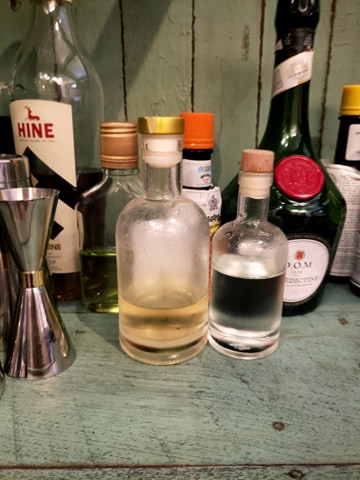Basic simple syrup is 1 cup of sugar to 1 cup of water. Combine both in a pot over medium heat, and heat until sugar is dissolved. Remove from heat and cool fully before pouring into a bottle or jar. Keep refrigerated. Stays good for about a month (if it gets cloudy or moldy at all, toss it out). I write about variations later on.

Simple syrups are great for adding sweetness to drinks without worrying about clumps of sugar at the bottom of the glass. Syrups are also an easy way to experiment with different flavors, since they’re so simple to make (see what I did there?). Infuse some mint into your syrup, and you’ve got a great mojito base. One of my favorite drinks, the penicillin, calls for honey ginger syrup. Passion fruit syrup is simply divine and goes great in tiki drinks. And a good rose syrup makes for a sweet and floral gin and tonic.
Syrups are also great for non-alcoholic drinks- coffee and tea, especially iced, go well with simple syrup, and adding a flavored syrup to some bubbly water makes for a tasty soda. Having ingredients on hand to make at least semi-fancy mocktails is important to me. I have friends that don’t imbibe, and sometimes I want to take a break from the alcohol myself. Or pace myself through the night by having mocktails in between cocktails (Mr. Cocktail Dork makes very strong drinks). Fancy and flavorful syrups mean I can whip up a drink that is going to be tasty and alcohol free.
To make a basic simple syrup, it’s just sugar and water in a one to one ratio. Easy peasy! You can make smaller batches, just stick with a one to one ratio. I generally use white sugar, since it’s a neutral sweet flavor, but you can use any type of sugar. Dark brown sugar gives a bit of a molasses flavor, and you can use splenda for something “sugar free.” Generally, any pure sugar/sweetener crystals should work in a one to one ratio.
However, when using liquid sugars, the ratio will change. For example, when using honey, I generally use 1.5 cups of honey to 1 cup of water. Unlike sugar crystals, honey has other components: trace amounts of vitamins and minerals, pollen (if using raw honey), and honey is about 17% water. To compensate for the volume of other components, it’s important to add a more honey to get the correct amount of sugars. This is true for other liquid sugars as well. I recommend starting with a 1.5 to 1 ratio, and experimenting to get the flavor you like.
To flavor syrups, infuse the water like you’re making tea. Bring the water and whatever flavors you want to add to a simmer without sugar. Simmer for about two minutes before adding sugar. Let cool completely before removing infusion ingredients. This method works for herbs (think mint or thyme), ginger, orange zest, or rose petals. If you are wanting to make a fruit syrup, it’s a little different. The best method I’ve found is to have a strainer over a metal bowl ready to go next to the stove. Make the syrup like normal, and add the fruit at the end. Simmer for 30 seconds to a minute, then immediately strain into the bowl. Fruit adds juice to the syrup, so it flavors it very quickly. If you don’t want an overly sweet juice, strain it quickly, then cool. Infused syrups won’t last as long, especially syrups with fruit in them. Keep them refrigerated, and use within a week (maybe two if it was infused with something light, like orange zest, but watch for any signs of contamination like mold or cloudiness).
There is also another variation: rich simple syrup. The method to make it is the same as basic simple syrup, but the ratio is 2 cups of sugar to 1 cup of water (if you keep adding sugar beyond this ratio you’re getting into supersaturated solution territory, which is great for making rock candy!). The benefit of a rich simple is you can reduce the amount of syrup in a recipe by half, and thus reduce the overall “watering down” of the drink. For example, if a recipe calls for one ounce of simple syrup, add half an ounce of rich simple syrup. Or if you want a really sweet drink, then by all means, add the stated amount. Some recipes might call for rich simple syrup directly, so it’s a good ingredient to know about.
It’s all about experimentation. Try different sugars with different infusions, make weird combinations (I will admit passion fruit thyme wasn’t my best idea), and have fun making exciting cocktails and mocktails with delicious, homemade, flavorful syrups.